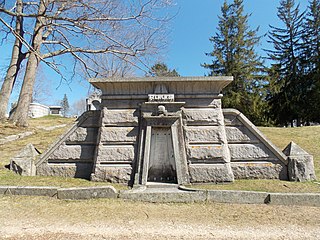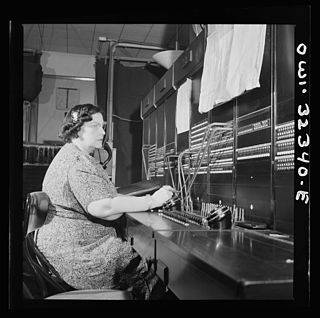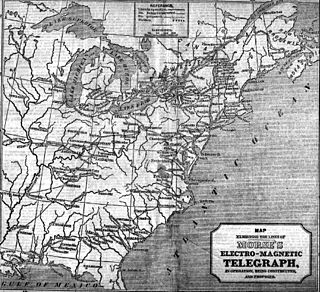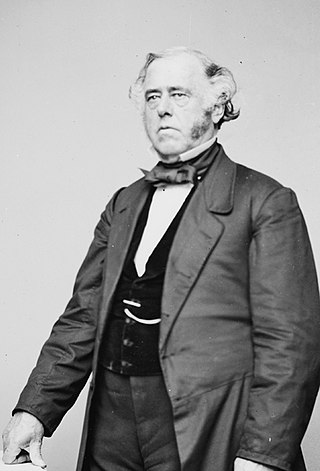
Samuel Finley Breese Morse was an American inventor and painter. After establishing his reputation as a portrait painter, Morse, in his middle age, contributed to the invention of a single-wire telegraph system based on European telegraphs. He was a co-developer of Morse code in 1837 and helped to develop the commercial use of telegraphy.

Cyrus West Field was an American businessman and financier who, along with other entrepreneurs, created the Atlantic Telegraph Company and laid the first telegraph cable across the Atlantic Ocean in 1858.

Ezra Cornell was an American businessman, politician, academic, and philanthropist. He was the founder of Western Union and a co-founder of Cornell University. He also served as president of the New York Agriculture Society and as a New York State Senator.

Alfred Lewis Vail was an American machinist and inventor. Along with Samuel Morse, Vail was central in developing and commercializing American electrical telegraphy between 1837 and 1844.

Henry Leavitt Ellsworth was a Yale-educated attorney who became the first Commissioner of the U.S. Patent Office, where he encouraged innovation by inventors Samuel F.B. Morse and Samuel Colt. Ellsworth also served as the second president of the Aetna Insurance Company, and was a major donor to Yale College, a commissioner to Indian tribes on the western frontier, and the founder of what became the United States Department of Agriculture.

Alexander Bain was a Scottish inventor and engineer who was first to invent and patent the electric clock. He installed the railway telegraph lines between Edinburgh and Glasgow.

Hiram W. Sibley, was an American industrialist, entrepreneur, and philanthropist who was a pioneer of the telegraph in the United States.

Thomas Thompson Eckert was an officer in the U.S. Army, Chief of the War Department Telegraph Staff from 1862 to 1866, United States Assistant Secretary of War from 1866 to 1867 and an executive at Western Union.

Anson Stager was the co-founder of Western Union, the first president of Western Electric Manufacturing Company and a Union Army officer, where he was head of the Military Telegraph Department during the American Civil War.

The F.O.J. Smith Tomb is an historic tomb in Evergreen Cemetery in Portland, Maine. It is the tomb of Francis Ormand Jonathan Smith (1806–76), US Congressman 1833-39. It was probably built by Smith in 1860, at the time of his daughter Lizzie's death, and is one of Maine's most sophisticated expressions of Egyptian Revival architecture. It was added to the National Register of Historic Places in 1974.
Henry O'Reilly was an Irish-American businessman and telegraphy pioneer.

John James Speed, Jr. was an American farmer, merchant, politician, and pioneer in telegraphy.
The Erie and Michigan Telegraph Company was formed by Francis Ormand Jonathan Smith to connect Buffalo, Cleveland, Detroit, Chicago and Milwaukee. Smith was a partner in ownership of the Morse patent. John James Speed was assigned to construct lines west of Detroit in 1845. The first portion was constructed by Jeptha Wade in 1847. Speed was named president when the company was organized, and later Ezra Cornell became president.
James Douglas Reid was a Scotsman who became general superintendent of the Magnetic Telegraph Company of which Amos Kendall was president in 1846. The Magnetic line linked Fort Lee to Philadelphia. Among those who incorporated the line was Samuel Morse. Reid was also superintendent of the Lake Erie Telegraph Company, and the Pittsburgh, Cincinnati & Louisville Telegraph Company. He wrote a detailed history of the telegraph industry

Women in telegraphy have been evident since the 1840s. The introduction of practical systems of telegraphy in the 1840s led to the creation of a new occupational category, the telegrapher, telegraphist or telegraph operator. Duties of the telegrapher included sending and receiving telegraphic messages, known as telegrams, using a variety of signaling systems, and routing of trains for the railroads. While telegraphy is often viewed as a males-only occupation, women were also employed as telegraph operators from its earliest days. Telegraphy was one of the first communications technology occupations open to women.

The Baltimore–Washington telegraph line was the first long-distance telegraph system set up to run overland in the United States.

Charles Minot was an American railroad executive at the Erie Railroad, where in 1850 he became Superintendent as successor of James P. Kirkwood, and was succeeded by Daniel McCallum in 1854. After the bankruptcy of the Erie in 1859 he was reinstated as general superintendent of the Erie railroad.

Leonard Dunnell Gale was a professor of chemistry and mineralogy who helped Samuel Morse develop the electromagnetic telegraph.

The timeline of North American telegraphy is a chronology of notable events in the history of the electric telegraphy in the United States and Canada, including the rapid spread of telegraphic communications starting from 1844 and completion of the first transcontinental telegraph line in 1861.

Benjamin Brown French (1800–1870) was a politician, telegraph business leader, Clerk of the U.S. House of Representatives, and Public Commissioner of Buildings in Washington, D.C. He was a member of the New Hampshire legislature from 1831 until 1833. He moved to Washington, D.C., where he served as Clerk of the United States House of Representatives from 1845 until 1847 and was appointed Commissioner of Public Buildings. He compiled an album of salt print and albumen print photographs related to construction of the Capitol dome and other sites. He was also involved in the burgeoning telegraph industry developed by Samuel Morse and others. His journals were published posthumously in edited form as Witness to the Young Republic.



















